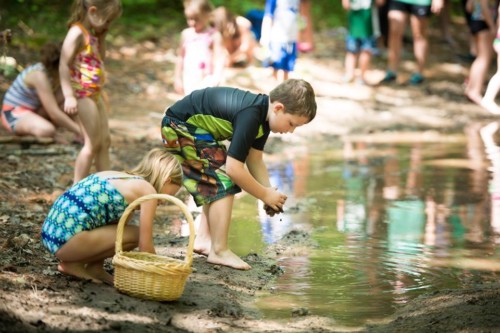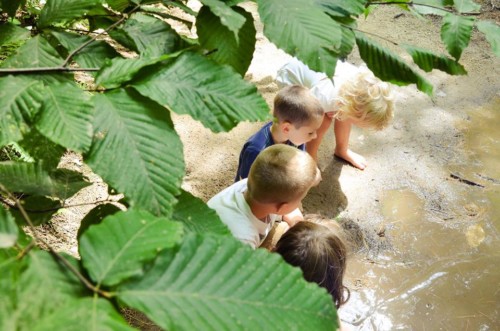
Why Kids (And You!) Need To Play Outside
In the past year or two, the habit of obsessive hand sanitizing has begun to wane, and probiotics have instead become the way towards better health, inside and out.
Less easily surrendered, however, is the much written about (and perhaps more frequently lampooned) culture of “helicopter parenting,” which sees children as fragile creatures that must be carefully moulded and constantly protected from themselves.
“A lot of kids are getting more and more unsafe because we [as parents] say, ‘Don’t spin, you’re going to get dizzy.’ ‘Get down from that rock, it’s unsafe!’ ‘Don’t climb that tree!'” says Angela Hanscom, a pediatric occupational therapist who now runs TimberNook, a camp-style program for kids that encourages unstructured outdoor play. “We’re actually becoming the barrier to child development by restricting them and keeping them from getting the sensory input that they need.”
While “play” and “free time” often carry a connotation of expendability and unimportance, being deprived of that unregulated time can have far reaching effects.
“When I became an occupational therapist, I started noticing that more children were coming in with mild sensory issues– but they were interesting sensory issues, like not liking wind in their face, not tolerating getting their hands dirty,” Hanscom explains. “But the number one issue was kids who were having trouble with their balance.”
Curious, Hanscom investigated.
“What’s happening is kids are in an upright position a lot– they’re not spinning in circles, going upside down, rolling down the hill, climbing trees, and moving the fluid back and forth in the inner ear,” Hanscom describes. As students, children often move from home to school in a car (where they sit in the upright position), then sit at school in the upright position for several hours, then get back in the car (once more in the upright position), then get dropped off at other afterschool activities (where they are likely also in an upright position), and finally returning home to do homework, in the upright position.
“When you move the fluid back and forth in the inner ear, that stimulates your balance sense– that’s your vestibular system,” clarifies Hanscom. “You need to be moving frequently throughout the day in order for that to stay strong. Even adults. You’ll hear a lot adults say, ‘When I was a kid I could go on spinny rides or rollercoasters.’ But when they’re older, they can’t tolerate those rides because they’re not moving in all different directions as much…In children and babies, that fluid can thicken and it can cause problems with their balance sense. That sense helps you get from point A to point B safely. It helps you stay in your seat without falling out. And it helps you to know where your body is in space.”
With her own children in mind, Hanscom experimented with creating “nature classes,” which eventually became TimberNook. Now with locations throughout the US, New Zealand, and Australia, TimberNook emphasizes developing children’s independence around play, encouraging them to rely on their own creativity.
“Now sports are great and my kids do sports,” Hanscom cautions. “But we [at TimberNook] really make sure [children] have plenty of free play because let’s say kids only do sports. It’s all drill oriented. All the kids are moving, all doing one thing at one time. With sports, you might be told, ‘You can’t spin right now, we’re all waiting in line right now.’
“Children’s neurological system will seek out the sensory input they need at any given time. So a young kid might need to spin in circles because they need to organize that sensory input and organize their brain. If you keep them from doing that, they can’t organize that sense. So they might be really hyperactive because they’ve never organized that.”
In this way, TimberNook brings together the hard science of research and medicine with the lighthearted chaotic nature of children’s play.
“Most occupational therapists are found indoors: in hospitals, in schools, in clinics,” Hanscom reflects. “I kept thinking– ‘What about outdoor play? Why are we not promoting independence with outdoor play?’…The environment is key in Timbernook. We’re looking at the development piece, at the therapeutic aspects. How is this inspiring children to play? Is it fostering their balance? Is it challenging them in different ways? Every experience is open ended and then it’s followed by hours of free play. We believe that free play is where it’s at.”
Yet while this solution to growing attention and balance disorders is seemingly evident (and easy!), it’s not always a simple choice.
“When I was growing up, you’d have one worksheet and then you were outside,” Hanscom recalls. “Now my daughter who’s in third grade has about two hours of homework each night. Even if I want her to play outside, I have this whole ethical issue: do they do the homework? Or do I say, ‘No, it’s too much’?”
Hanscom continues, “There’s this mismatch of what’s appropriate for children and what children should be doing– which is playing outside– and what they’re really doing is being carted from activity to the next.”
Ultimately, Hanscom emphasizes information and (of course) taking what action you can.
“The key to change is knowledge. I think once people realize that we’re actually at the point where we’re causing harm to children, it’s really hard to go back and to keep doing harm,” Hanscom says, addressing the problem of schools (and reduced recess times) specifically. “Some of the children are really young and their free play is being taken away– but they’re not done developing yet. The first seven years are really critical.”
So what about teenagers and adults?
“You can make changes to your vestibular system,” Hanscom reassures. “It just starts with moving more. Taking a dance class, going outside, kayaking.”
At the end of the day, Hanscom’s instructions are simple: “Moving your body in different directions is what you need to do.”
To learn more about TimberNook, or the science of outdoor play, visit their website.




































